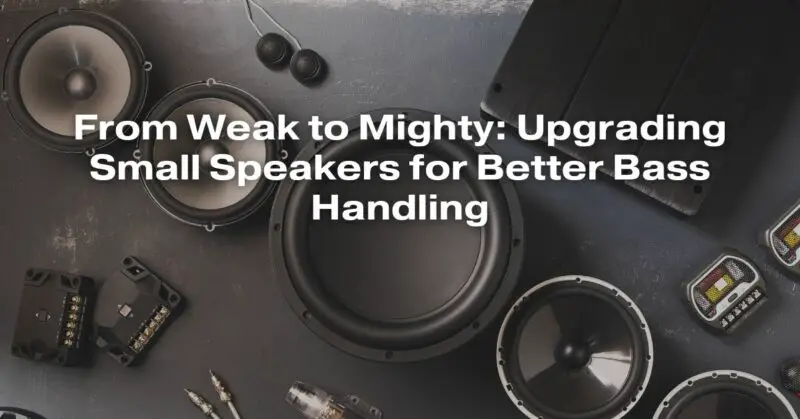Small speakers have come a long way in recent years, delivering impressive sound quality from compact and portable devices. However, one common limitation of these speakers is their relatively weak bass performance. The physics of speaker design often restricts the ability of small speakers to produce deep and powerful bass frequencies. Fortunately, there are ways to overcome these limitations and upgrade small speakers for better bass handling. In this comprehensive article, we will explore the science behind small speaker limitations, discuss various methods to enhance bass performance, and provide practical tips for achieving a mighty bass output from your compact speakers.
The Physics of Small Speaker Limitations
To understand why small speakers struggle with bass reproduction, we need to delve into the fundamental principles of speaker design. A speaker produces sound by vibrating a diaphragm (usually made of paper, plastic, or other materials) in response to an electrical signal. These vibrations create pressure waves in the air that our ears perceive as sound.
The ability of a speaker to reproduce bass frequencies depends on several factors:
- Diaphragm Size: The size of the diaphragm or driver is a critical factor. Larger drivers can move more air, which is essential for producing lower frequencies. Small speakers typically have smaller drivers, making it challenging to produce deep bass.
- Enclosure Size: The size and design of the speaker enclosure also play a crucial role. Smaller enclosures have limited space for air movement, which can lead to reduced bass output and distortion.
- Power Handling: Small speakers often have lower power handling capabilities compared to larger ones. Bass frequencies demand more power to move the diaphragm effectively, so small speakers may struggle to deliver sufficient power for impactful bass.
- Frequency Response: The frequency response of a speaker refers to its ability to reproduce various frequencies accurately. Small speakers tend to have limited low-frequency response due to their physical constraints.
Now that we understand the limitations let’s explore the strategies to upgrade small speakers for better bass handling.
Upgrading Small Speakers for Better Bass
- Passive Radiators: One way to enhance bass in small speakers is by adding passive radiators. These are non-powered diaphragms that resonate sympathetically with the active driver, creating a more pronounced bass response without increasing the size of the enclosure significantly. Passive radiators can be a cost-effective way to boost bass in small speakers.
- Ported Enclosures: Ported enclosures are designed with specific openings or ports that allow air to escape, enhancing bass response. By carefully tuning the port size and placement, you can optimize the speaker’s bass output without making the enclosure much larger.
- Digital Signal Processing (DSP): Some small speakers incorporate DSP technology that can manipulate the audio signal in real-time to compensate for bass limitations. DSP can help extend the low-frequency response and reduce distortion, providing a fuller and cleaner bass sound.
- Amplification: If your small speakers have a dedicated subwoofer output, consider adding an external powered subwoofer. This will offload the bass duties from your small speakers, allowing them to focus on mid and high frequencies while the subwoofer handles the low-end, resulting in a more balanced and powerful sound.
- Equalization: Many small speakers come with built-in EQ settings. Experimenting with these settings can help you find the right balance for your preferred sound profile, potentially boosting the bass without the need for additional hardware.
- Placement and Room Acoustics: Proper placement of your small speakers can also influence their bass performance. Placing them near walls or in corners can sometimes result in a perceived increase in bass due to room acoustics. Experiment with speaker placement to find the sweet spot.
- Use of Bass-Heavy Music: Choosing music with strong bass elements can help mask the limitations of small speakers. Bass-heavy tracks can make the most of the available bass response, creating a more satisfying listening experience.
Conclusion
Small speakers have made remarkable strides in delivering high-quality audio from compact packages, but their bass performance often leaves something to be desired due to the constraints of their size. However, by understanding the physics of speaker design and implementing various strategies, you can upgrade your small speakers for better bass handling. Whether you opt for passive radiators, ported enclosures, DSP technology, amplification, or simply experiment with placement and room acoustics, there are solutions to make your small speakers sound mighty. With these upgrades, you can enjoy deeper, more impactful bass without sacrificing the convenience and portability of your small speakers, enhancing your overall listening experience.


